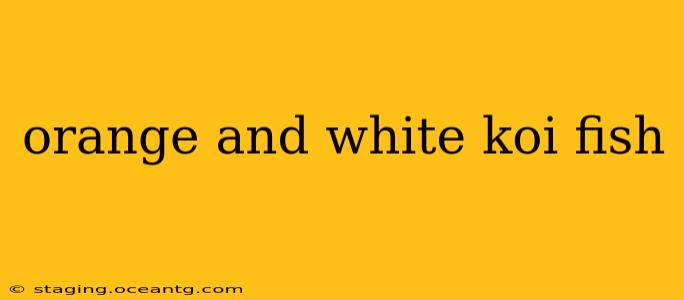Koi fish, with their vibrant colors and graceful movements, have captivated people for centuries. Among the many stunning varieties, the orange and white koi stands out, combining the energy of orange with the purity of white. This captivating color combination holds significant symbolic meaning and makes these fish a popular choice for ponds and aquariums worldwide. This article delves into the fascinating world of orange and white koi, exploring their symbolism, care, and the different variations within this beautiful color scheme.
What is the Meaning of Orange and White Koi?
The meaning of orange and white koi is multifaceted, drawing from the individual symbolism of each color. Orange, a vibrant and energetic color, often represents joy, enthusiasm, and creativity. It symbolizes good fortune, courage, and ambition. White, on the other hand, embodies purity, innocence, and peace. It represents clarity, spiritual growth, and a connection to the divine. Together, orange and white koi represent a harmonious blend of energy and tranquility, a balance between passion and serenity. This combination makes them a powerful symbol of good luck and prosperity.
What are Some Different Types of Orange and White Koi?
The beauty of orange and white koi lies in its diversity. Several variations exist, each with its unique pattern and intensity of color. Some of the most common include:
-
Hi Utsuri: This variety features a striking black base color overlaid with bright orange and white patches. The contrast is dramatic and visually stunning.
-
Showa Sanshoku: Showa Sanshoku koi exhibit a black base with orange and white markings. The markings are often bolder and more defined than in other varieties.
-
Kohaku: While technically not solely orange and white (often featuring a red/orange), Kohaku are frequently seen with varying shades of orange and white, making them aesthetically similar and frequently included in discussions about orange and white koi. The pattern is typically a white base with bright orange patches.
-
Sanke: Similar to Kohaku, but also incorporates black markings, the Sanke shows a fascinating mix of orange, white, and black, and some may lean strongly toward the orange and white colour scheme.
How Do I Care for Orange and White Koi?
Caring for orange and white koi requires commitment and attention to detail. Here's a brief overview:
-
Water Quality: Maintaining pristine water quality is crucial. Regular water changes and filtration are essential to prevent disease and maintain a healthy environment.
-
Diet: A balanced diet is key to vibrant colors and overall health. Feed your koi a high-quality commercial koi food, supplemented with occasional treats like blanched vegetables.
-
Pond Size: Ensure your pond is adequately sized to accommodate the koi's growth. Overcrowding can lead to stress and disease.
-
Temperature: Koi are sensitive to temperature fluctuations. Maintain a stable water temperature within their preferred range.
-
Disease Prevention: Regular monitoring for signs of disease is vital. Quick action can often prevent minor issues from becoming major problems.
What is the Best Food for Orange and White Koi?
Providing your orange and white koi with a nutritious diet is crucial for maintaining their vibrant colors and overall health. A high-quality commercial koi food formulated for their specific needs is recommended. This food should contain a balance of protein, carbohydrates, and essential vitamins and minerals to support healthy growth and development. Look for options with high color-enhancing ingredients for maximum vibrancy in your fish’s appearance.
Are Orange and White Koi Expensive?
The price of orange and white koi can vary greatly depending on several factors including the variety, size, quality, and lineage. High-quality show koi, especially those with exceptional patterns and coloration, can command significant prices. However, you can also find beautiful orange and white koi at more affordable prices, depending on your needs and preferences.
How Can I Tell if My Orange and White Koi is Healthy?
Healthy orange and white koi are active, alert, and have vibrant colors. Look for clear, bright eyes, smooth scales, and a healthy appetite. Any signs of lethargy, discoloration, or unusual behavior should be investigated promptly. Early detection of health problems can improve treatment success.
In conclusion, orange and white koi are a mesmerizing addition to any water garden. Their striking beauty, symbolic meaning, and relatively straightforward care make them a popular choice for both novice and experienced koi keepers. By understanding their needs and appreciating their unique elegance, you can bring years of joy and wonder to your water feature.
